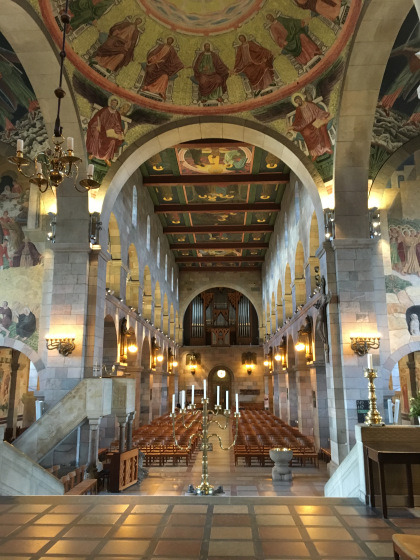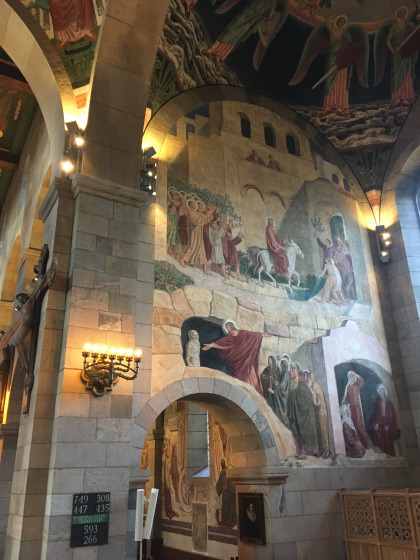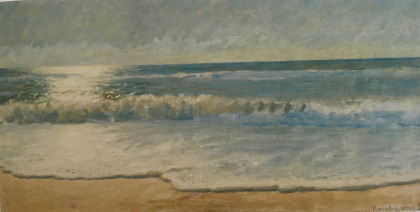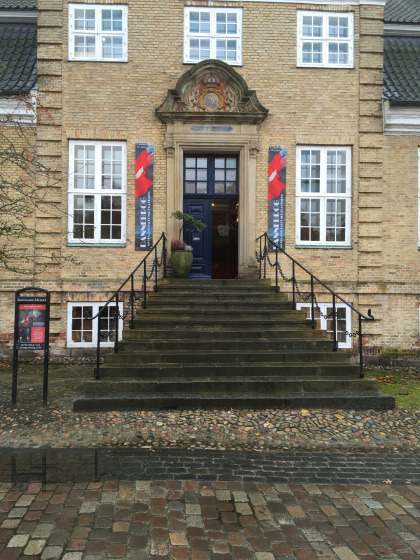#Thorvald Bindesbøll
Explore tagged Tumblr posts
Text
Dragon Fountain
Postcard from Denmark The Dragon Fountain is a fountain located in the City Hall Square in Copenhagen, Denmark. It was designed by Joakim Skovgaard in collaboration with Thorvald Bindesbøll and features a bull in combat with a dragon. Tuesday Take Me To…
0 notes
Text
Dragespringvandet er tilbage
Københavns Kommune skriver: MONUMENTMANDEN FORTÆLLER – for sidste gang Så lykkedes det endelig af få genopstillet Thorvald Bindesbølls og Joakim Skovgaards Dragespringvand i sin fulde pragt, som det så ud, indtil det blev flyttet i 1954. Årsagen til flytningen var en større udvidelse af Vestre Boulevard, som derpå fik navnet H.C. Andersens Boulevard. Der var dog ikke længere plads til den ydre…

View On WordPress
1 note
·
View note
Photo


Thorvald Bindesbøll was a Danish architect and Art Nouveau designer who created some of the most iconic logos and labels in Danish 20th Century culture. His life’s work forms part of the Danish Cultural Canon.
Bindesbøll did not receive many commissions for architecture during his life time, and therefore turned to design. His bold ceramic jugs are famous, as are his fountains, book designs, and not least logos. No Dane is unfamiliar with his classic “Hof” label for Carlsberg Beer from 1904, which in modernized form is still in use.
Among his relatively few buildings, a favorite is the wooden fish packing house in Skagen (1907) which now houses a high-end seafood restaurant.
#design#dansih design#arts and crafts#danish architect#thorvald bindesbøll#1900s#art nouveau#skønvirke#carlsberg#hof#pilsner#beer label#fiskepakhuset skagen#skagen#danish cultural canon
2 notes
·
View notes
Photo



Thorvald Bindesbøll (1846-1908) was one of Denmark's first modern designers. He designed many different types of objects including furniture, bookbinding, jewellery, carpets, lamps, posters, monuments, and embroidery. He even designed the Carlsberg beer label. Bindesbøll drew inspiration from Japanese art and craft.
Michael Anchrer - Thorvald Bindesbøll, 1803, oil on canvas
#Michael Anchrer#michael peter ancher#oil painting#oil on canvas#1803#1800s#portrait#Thorvald Bindesbøll#designer#modern designer#danish artist#denmark#skagen#skagen painter#Skagensmalerne#craftsman#jutlan#impressionism#realism#naturalism#carlsberg beer
0 notes
Photo

Anna Ancher reading in the living room - Helga Ancher
Danish, 1883-1964
Oil on canvas
#Helga Ancher#danish artist#female portrait#reading art#interior#Thorvald Bindesbøll's lamp#lamp light
234 notes
·
View notes
Photo

Fish serving set, P. Hertz, 1905, Minneapolis Institute of Art: Decorative Arts, Textiles and Sculpture
ornate handles; pierced blade Peter Hertz, the oldest silver factory in Copenhagen, produced designs by Thorvald Bindesbøll and Johan Rhode (the latter being an important designer for the best-known Danish silver manufacturer, Georg Jensen). The designer of this service clearly drew upon ancient Norse designs, similar to the Celtic imagery of medieval Britain, with interlaced decorative elements including numerous dragons. The revival of folk imagery in material culture during the late 19th century, known as the National Romantic movement, could be found throughout the Nordic countries. Artists adopted historic imagery such as Viking ships or traditional decorative motifs as countries struggled for political independence or cultural distinction. These activities also corresponded with the Arts and Crafts movement taking place as a reaction to industrialization through a revival of handcrafted wares. The resulting style, exemplified in this fish serving set, both honors craft tradition and adopts a more nationalistic overtone by referencing folk history. Size: 2 1/8 x 2 7/8 x 1 in. (5.4 x 7.3 x 2.54 cm) Medium: Silver
https://collections.artsmia.org/art/5776/
17 notes
·
View notes
Text


The Mermaid (Havfruen) - illustration for Holger Drachmann's "Troldtøj" ~ Copenhagen, 1889-1890 ~ collaboration by Thorvald Bindesbøll (Danish National romantic architect, sculptor and ornamental artist, 1846-1908) & August Andreas Jerndorff (Danish painter, 1846–1906)
41 notes
·
View notes
Link
In 1923 Knud Valdemar Engelhardt (1882–1931) designed the street signs for the Copenhagen suburb of Gentofte. The type design was loosely based on the lettering of two Danish architects of the time: Thorvald Bindesbøll (designer of the Carlsberg logo) and Anton Rosen. The signs were so successful that they’re still in use today.
I wanted to have a look at Scandinavian typography to perhaps inspire me for my final outcome. Kontrapunkt’s (design agency in Copenhagen) custom typeface for DSB, it very classic and readable, although very different from what the UK uses for signs, Helvetica, it still works and gives the place names some character.
0 notes
Text
The Skovgaard Family
Some families seem to be able to produce so much talent in generations. One of those families is the Skovgaard family. In Viborg Cathedral, you can see frescos made by Joakim Skovgaard (1856-1933). The decoration in the church is one of the hugest church works in Denmark.

A view into Viborg Cathedral with Joakim Skovgaard frescos and paintings

A view into Viborg Cathedral with Joakim Skovgaard biblical murals and paintings
In my childhood, before I could read, I often looked at his sketches in my parent’s book of the motives used for the church frescos. They were dramatic, and I was afraid of the sight of the drowning people at the sin flood. By looking at the page in the scetch book, I observed Adam and Eve being driven out of Eden thinking about the severe consequences of our actions can have.
At his time, Joakim was more famous than his brother Niels (1858-1938), who is now having a renaissance. Both of them travelled abroad to learn from other artists and explore motives and light in other countries.
This slideshow requires JavaScript.
Some of Joakim Skovgaard’s works
Their sister Susette 1863-1937, could not as a woman attend the art Academy as her brothers but took private lessons in painting.
Susette Cathrine Holten, nee Skovgaard (1863-1937) “Peonies in a lilac vase.”
Artist Johanne Krebs’ A portrait of Susette Cathrine Holten, nee Skovgaard.
Susette Cathrine Holten, nee Skovgaard (1863-1937) Flowers
Suzette Holten, nee Skovgaard inspired by the Japanese style 1916
Susette was five years old when her mother died and twelve years old when her father passed away. The brothers stayed in the house with a painter who lived there and Susette moved across the street to friends of the family where Hans Christian Andersen often visited to entertain the children.
Niels Skovgaard

Niels Skovgaard, View over the sea in Jutland, Denmark, 1894. He was inspired by the Impressionists
In their childhood, all three Skovgaard siblings also got training by their father P.C. Skovgaard (1817-1875), who was famous in the so-called “Golden Age” of Romanticism. He mostly painted landscapes. His faith in God and in our National State of Denmark shines through his works.
When the Skovgaard siblings were still children, they lost their mother during the birth of a stillborn child. In a letter on display at the museum, a relative described the last hours before she died. The family had a strong faith in God during this enormous loss.
P.C. Skovgaard’s painting of his daughter Suzette seven years old, 1870
P.C. Skovgaard’s portrait of his youngest son Niels Skovgaard thirteen years old in 1871.
P.C. Skovgaard painting of his fourteen years old son, Joakim Skovgaard in 1871
Their father P.C. Skovgaard painted the children a few years after their mother’s death. P.C. Skovgaard lived in a time of Nationalism where Denmark and other countries strived to get away from the total power of the king and gain independence. He was among famous artists and thinkers who fought for this cause and his he painted Danish landscapes to illustrate the beauty of green beech trees like a metaphor of our nationality. Inspired by other revolutions, we got our Constitution in 1849. Our transition from absolute monarchy was peaceful as it is said about our national character that the intervals between our meals are too short of making a revolution.
P.C Skovgaaard Landscape at Capri, Italy 1869
P.C. Skovgaard 1957-1860. Quiet summer evening at Hellebæk lake
P.S. Skovgaard, 1850, View over Møns klint in Denmark
I am impressed that they all managed so well in their life. They were skilled artists, and Joakim and Niels raised large families. They, like their father before them, were friends with thinkers and artists of their time. One of them was Thorvald Bindesbøll who performed in clay and sculpture and silver, was inspired by the English Beaux-Arts. All three siblings made art of pottery for decoration and use in households as well of paintings.
Thorvald Bindesbøll’s glazed terracotta vase. T.B was a good friend of Joakim Skovgaard
A silver vase by Bindesbøll
Painter Joakim Skovgaard’s portrait of Thorvald Bindesbøll, who established Danish design inspired by the English Art & Craft movement
Joakim Skovgaard. 1886, a ploughman, horses and seagulls on pottery
In Viborg, since 1937 the old town Hall is the Skovgaard Museum. The museum is situated at the same square as the Cathedral with the eighty-four biblical frescos created by Joakim Skovggard.

Part of the Skovgaard Museum in Viborg
For more information on the museum, please visit the link above.
A Talented Danish Art Family The Skovgaard Family Some families seem to be able to produce so much talent in generations. One of those families is the Skovgaard family.
0 notes
Text
Hej meine Lieben, mitte Juni war ich kurz in Leipzig und habe mir die Made in Denmark-Ausstellung angesehen, die vom 2. Juni bis zum 7. Oktober 2018 im GRASSI Museum für Angewandte Kunst mit 320 Objekten präsentiert wird. Leipzig? Das ist doch ziemlich ungewöhnlich, oder? Ich persönlich würde so eine Ausstellung auch eher in Hamburg, Kiel oder Rostock, also Norddeutschland erwarten. Aber auch in Mitteldeutschland ist dänisches Design sehr beliebt und die Ausstellungen rund um Design aus Dänemark haben schon seit Jahrzehnten eine Tradition im Leipziger GRASSI Museum. Doch dazu später mehr. Wenn Ihr also mal in Leipzig seid oder aus der Umgebung kommt, schaut mal vorbei. Hier kommen aber erst mal meine persönlichen Eindrücke von der Made in Denmark-Ausstellung. Euer Stefan.
Meine Eindrücke aus der Made in Denmark-Ausstellung
Vom Leipziger Bahnhof sind es nur ein wenige Minuten zu Fuss bis zum GRASSI Museum. Genauer gesagt sind es nur zehn Minuten. Perfekt für Alle, die mit dem Zug nach Leipzig anreisen wollen für diese Ausstellung. Am Johannisplatz angekommen, kann man das Museum dank einer großen Schrift gar nicht übersehen. Oder doch? Der Eingang ist etwas versteckt. Zunächst geht man zur Kasse und gegenüber im Gebäude ist dann die Ausstellung selbst, die von Kuratorin Sabine Epple ins Leben gerufen wurde. Ihr könnt Eure Sachen im Spind einschließen und schon geht es in die hyggelige Ausstellung.
Im Vorraum der Ausstellung begrüßt einen gleich die Pendelleuchte PH Artichoke von Poul Henningsen. Hier fühlt man sich sofort wohl – überall dänisches Design.
Ich bin gespannt, was mich erwarten wird. Wenn ich an dänisches Design denke, denke ich an Marken, wie Royal Copenhagen, Kähler Design, Louis Poulsen, Stelton, Georg Jensen, Holmegaard und Kay Bojesen. Sind diese auch in der Ausstellung zu sehen? Alles beginnt mit dem dänischen Jugendstil und Thorvald Bindesbøll.
Um 1900: Wegbereiter der dänischen Moderne. Es ist sehr interessant zu sehen, wo große dänische Marken Ihre Wurzeln haben. Zum Beispiel die zwei Dorsche von Royal Copenhagen.
Art déco und Funktionalismus. Auch hier sieht man auf dem mittleren Foto die weißen Porzellanfiguren, die von Royal Copenhagen stammen.
Made in Denmark – ein internationales Markenzeichen. Kommen wir zu einem Teil der Ausstellung, wo ich mich besonders gut aufgehoben fand. Ihr erkennt sicherlich auch viele dänische Design-Klassiker, oder? Den roten Egg Chair von Arne Jacobsen, die Stechleuchte AJ und die Holzfiguren von Kay Bojesen gibt es heute immer noch zu erwerben.
Dänische Keramiker: zwischen Serie und künstlerischem Unikat. Hättet Ihr gedacht, dass das Objekt links auf dem ersten Bild von Bj��rn Wiinblad stammte?
Von der Postmoderne ins Heute.
Für Kinder sind Ausstellungen ja oft langweilig, wenn es keine interaktiven Elemente gibt. In der Made in Denmark-Ausstellung gibt es für Kinder einen sehr schön eingerichteten Raum (genau gesagt 15 Quadratmeter), wo sie im Fernsehen die Olsenbande sehen können, Hygge Bücher durchblättern oder mit dänischen Spielzeug von LEGO und Kay Bojesen spielen können. Sehr tolle Idee!
Dänische Tradition im GRASSI Museum Leipzig
Das GRASSI Museum hat mittlerweile über 900 dänische Design-Objekte zusammengetragen. Schon 1874 gehörten Keramiken aus Dänemark zur Museumssammlung, wie man dem Ausstellungskatalog entnehmen kann. Seither gab es immer wieder Sonderausstellungen und Ausstellungen anderer Art, um die dänischen Exponate zu zeigen. Seit 2015 verdoppelte sich durch Spenden der Bestand an dänischen Objekten.
Made in Denmark-Ausstellungskatalog
Für Alle, die sich etwas dänisches Design mit nach Hause nehmen wollen, gibt es im Museumsshop einen Ausstellungskatalog für 38,00 Euro mit 276 Seiten und 250 Abbildungen. Die Sprache ist in Deutsch und Englisch. Das Grußwort stammt von Mette Bock, Ministerin für Kultur in Dänemark. Neben der dänischen Formgebung im Leipziger GRASSI Museum beinhaltet der Katalog acht Kapitel dänisches Design von 1900 bis heute mit Objekten der Ausstellung. Von daher ist es ein gutes Nachschlagewerk, wenn man mit vielen Inspirationen aus der Ausstellung nach Hause kommt oder vielleicht noch eine Geschenkidee sucht.
Mehr Informationen zur Made in Denmark-Ausstellung auf einen Blick:
Das GRASSI Museum für Angewandte Kunst befindet sich am Johannisplatz 5-11 (04103 Leipzig). Es ist zu Fuss etwa in zehn Minuten vom Bahnhof erreichbar. Der Eintritt liegt bei 8,00 Euro. Alle unter 18 Jahre dürfen kostenlos rein. Die Öffnungszeiten sind Dienstag bis Sonntag, Feiertage, 10 bis 18 Uhr. Montags ist das Museum geschlossen. Neben der Ausstellung gibt es auch begleitende Veranstaltungen. Mehr Informationen dazu findet Ihr direkt auf der Webseite des Museums.
Heute mal ein Beitrag über meinen Besuch der Made in Denmark-Ausstellung im GRASSI Museum Leipzig mit viel Design aus #Dänemark #Grassihygge Hej meine Lieben, mitte Juni war ich kurz in Leipzig und habe mir die Made in Denmark-Ausstellung angesehen, die vom 2.
0 notes
Text
Fieldwork

For our filedwork we visited various places mostly in the Sliema area. The first place which we visited was cafe jubilee at Gzira. As soon as I arrived the first thing that I noticed was the logo on the outside which was of art nouveau style. Then we went inside and started observing and taking pictures of relevant graphic designs. Below are some of the images which we took:

This shot here was taken exactly before we entered. On this wall there are a lot of posters that are of Art Nouveau Style and below I will talk about one of the posters which caught my attention.

The poster which caught my attention has the title of “La Boheme”. It is made up of warm colors and serif font. Later I researched about this poster and found out that La bohème is an opera in four acts, composed by Giacomo Puccini to an Italian libretto by Luigi Illica and Giuseppe Giacosa. After this we went inside and asked for permission to take photos.

A poster that i really liked was this carlsberg poster which is hung to one of the walls inside the café. The font used in this design is serif font. After some research I found out that the Carlsberg logo was created In 1904 in Art Nouveau-style and has been used nearly unmodified ever since. It was designed by Thorvald Bindesbøll, a key figure on the European scene and Denmark’s most original designer to date. Thorvald Bindesbøll was a Danish architect. He was one of Denmark’s most important architects at the turn of the twentieth century. He was born into an architectural family; he was the son of Michael Gottlieb Bindesbøll. Then we continued to look around and immediately noticed this huge artwork:

This piece of art was drawn by Carlino Gelfo. It was a perfect example of the art nouveau style as it featured a beautiful woman with beautiful hair. Her hairs features intertwined organic forms, mostly curvaceous in shape and also it is made up of warm colors. Later I researched about this and found out that Alfons Mucha had created an Advertisement for Biscuits Lefèvre-Utile in 1897. In his artwork which can be seen below we can see how much Carlino Gelfo was inspired by it as the woman in his artwork and the woman in the artwork of Alfons Mucha look almost exactely the same.
Then we decided to leave Café Jubilee and decided to look around in the Sliema area to see whether we can find architecture of Art Nouveau Style. The buildings we found had designs of leaf motifs and featured a floral style which are both characteristics of Art Nouveau. Below are some of the shots that we took:






On another day we decided to visit white rocks in Pembroke as a friend of mine had told us that there were many graffiti artworks there and thus we decided that it would be worth it to visit this place and do some research about graffiti. Below are some of the shots that we took:

This interactive artwork was the one that caught my attention the most as I had to stop for a while and see exactly what the message that it was trying to deliver was. After a while I realised that the pathway actually represents a monitor on which the two characters on the sides are playing using the controllers in their hands. Also this artwork reminded me of Stefan Sagmeister as he is an artist that uses a lot of interactivity in his designs.

This artwork here probably drew inspiration from Psychedelia.
Here are a few other images from the shots we took:



0 notes
Photo

Thorvald Bindesbøll - Earthenware Vase with Green and Brown Glaze (30.5cm), 1892 / Earthenware Vase with Green and Brown Glaze (31.5cm), 1892.
1 note
·
View note
Photo

Fish serving set, P. Hertz, 1905, Minneapolis Institute of Art: Decorative Arts, Textiles and Sculpture
ornate handles; pierced blade Peter Hertz, the oldest silver factory in Copenhagen, produced designs by Thorvald Bindesbøll and Johan Rhode (the latter being an important designer for the best-known Danish silver manufacturer, Georg Jensen). The designer of this service clearly drew upon ancient Norse designs, similar to the Celtic imagery of medieval Britain, with interlaced decorative elements including numerous dragons. The revival of folk imagery in material culture during the late 19th century, known as the National Romantic movement, could be found throughout the Nordic countries. Artists adopted historic imagery such as Viking ships or traditional decorative motifs as countries struggled for political independence or cultural distinction. These activities also corresponded with the Arts and Crafts movement taking place as a reaction to industrialization through a revival of handcrafted wares. The resulting style, exemplified in this fish serving set, both honors craft tradition and adopts a more nationalistic overtone by referencing folk history. Size: 2 1/8 x 2 7/8 x 1 in. (5.4 x 7.3 x 2.54 cm) Medium: Silver
https://collections.artsmia.org/art/5776/
7 notes
·
View notes
Photo


The Mermaid, Havfruen - Illustrasjon til Holger Drachmanns “Troldtøj”, København ~ 1889-1890 ~ Thorvald Bindesbøll & August Jerndorff
167 notes
·
View notes
Photo

“Havfruen - Illustrasjon til Holger Drachmanns "Troldtøj", København 1889-1890″
by Thorvald Bindesbøll & August Jerndorff
191 notes
·
View notes
